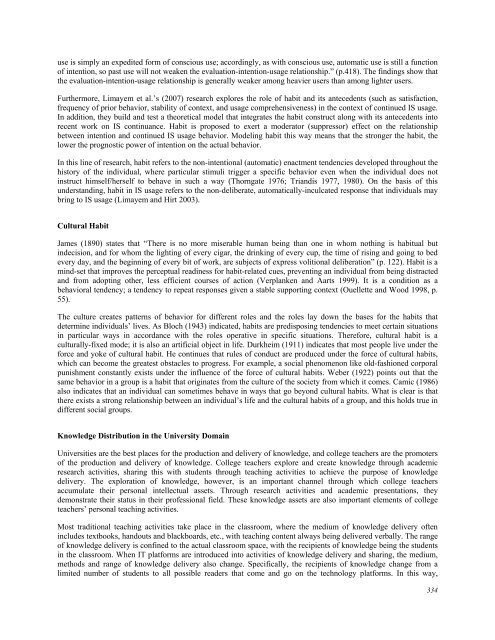October 2012 Volume 15 Number 4 - Educational Technology ...
October 2012 Volume 15 Number 4 - Educational Technology ...
October 2012 Volume 15 Number 4 - Educational Technology ...
Create successful ePaper yourself
Turn your PDF publications into a flip-book with our unique Google optimized e-Paper software.
use is simply an expedited form of conscious use; accordingly, as with conscious use, automatic use is still a function<br />
of intention, so past use will not weaken the evaluation-intention-usage relationship.” (p.418). The findings show that<br />
the evaluation-intention-usage relationship is generally weaker among heavier users than among lighter users.<br />
Furthermore, Limayem et al.’s (2007) research explores the role of habit and its antecedents (such as satisfaction,<br />
frequency of prior behavior, stability of context, and usage comprehensiveness) in the context of continued IS usage.<br />
In addition, they build and test a theoretical model that integrates the habit construct along with its antecedents into<br />
recent work on IS continuance. Habit is proposed to exert a moderator (suppressor) effect on the relationship<br />
between intention and continued IS usage behavior. Modeling habit this way means that the stronger the habit, the<br />
lower the prognostic power of intention on the actual behavior.<br />
In this line of research, habit refers to the non-intentional (automatic) enactment tendencies developed throughout the<br />
history of the individual, where particular stimuli trigger a specific behavior even when the individual does not<br />
instruct himself/herself to behave in such a way (Thorngate 1976; Triandis 1977, 1980). On the basis of this<br />
understanding, habit in IS usage refers to the non-deliberate, automatically-inculcated response that individuals may<br />
bring to IS usage (Limayem and Hirt 2003).<br />
Cultural Habit<br />
James (1890) states that “There is no more miserable human being than one in whom nothing is habitual but<br />
indecision, and for whom the lighting of every cigar, the drinking of every cup, the time of rising and going to bed<br />
every day, and the beginning of every bit of work, are subjects of express volitional deliberation” (p. 122). Habit is a<br />
mind-set that improves the perceptual readiness for habit-related cues, preventing an individual from being distracted<br />
and from adopting other, less efficient courses of action (Verplanken and Aarts 1999). It is a condition as a<br />
behavioral tendency; a tendency to repeat responses given a stable supporting context (Ouellette and Wood 1998, p.<br />
55).<br />
The culture creates patterns of behavior for different roles and the roles lay down the bases for the habits that<br />
determine individuals’ lives. As Bloch (1943) indicated, habits are predisposing tendencies to meet certain situations<br />
in particular ways in accordance with the roles operative in specific situations. Therefore, cultural habit is a<br />
culturally-fixed mode; it is also an artificial object in life. Durkheim (1911) indicates that most people live under the<br />
force and yoke of cultural habit. He continues that rules of conduct are produced under the force of cultural habits,<br />
which can become the greatest obstacles to progress. For example, a social phenomenon like old-fashioned corporal<br />
punishment constantly exists under the influence of the force of cultural habits. Weber (1922) points out that the<br />
same behavior in a group is a habit that originates from the culture of the society from which it comes. Camic (1986)<br />
also indicates that an individual can sometimes behave in ways that go beyond cultural habits. What is clear is that<br />
there exists a strong relationship between an individual’s life and the cultural habits of a group, and this holds true in<br />
different social groups.<br />
Knowledge Distribution in the University Domain<br />
Universities are the best places for the production and delivery of knowledge, and college teachers are the promoters<br />
of the production and delivery of knowledge. College teachers explore and create knowledge through academic<br />
research activities, sharing this with students through teaching activities to achieve the purpose of knowledge<br />
delivery. The exploration of knowledge, however, is an important channel through which college teachers<br />
accumulate their personal intellectual assets. Through research activities and academic presentations, they<br />
demonstrate their status in their professional field. These knowledge assets are also important elements of college<br />
teachers’ personal teaching activities.<br />
Most traditional teaching activities take place in the classroom, where the medium of knowledge delivery often<br />
includes textbooks, handouts and blackboards, etc., with teaching content always being delivered verbally. The range<br />
of knowledge delivery is confined to the actual classroom space, with the recipients of knowledge being the students<br />
in the classroom. When IT platforms are introduced into activities of knowledge delivery and sharing, the medium,<br />
methods and range of knowledge delivery also change. Specifically, the recipients of knowledge change from a<br />
limited number of students to all possible readers that come and go on the technology platforms. In this way,<br />
334

















